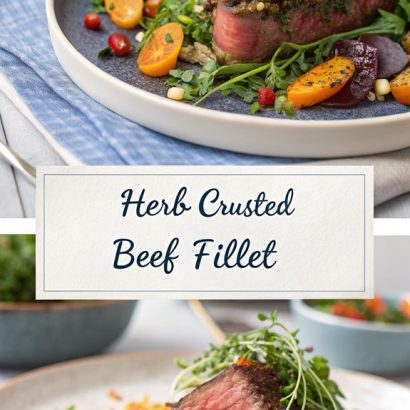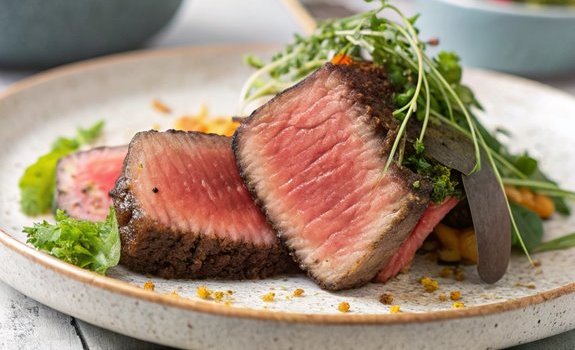Intricate Dinner Recipes
Did you know that nearly 60% of home cooks enjoy the challenge of preparing intricate dinner recipes? This statistic highlights a growing trend among culinary enthusiasts who seek to elevate their meals beyond the ordinary. By exploring these complex dishes, you not only refine your skills but also impress those around you with stunning presentations and rich flavors. However, the journey to mastering these recipes often comes with its own set of challenges and surprises, which begs the question: what should you consider before tackling your next culinary masterpiece?
Why You’ll Love This Recipe
When you plunge into this recipe, you’ll discover a world of benefits that make cooking not just a chore but an enjoyable experience.
You’ll appreciate the improvised preparation, giving you flexibility in choosing ingredients and timing. Engaging in meal planning involves everyone, enhancing social interaction and family bonding.
Plus, the recipe offers a variety of options to cater to different tastes and occasions. It promotes healthier eating by allowing you to control ingredients while reducing food allergies. Cooking at home also provides financial benefits by saving money compared to dining out.
You’ll find cognitive stimulation as you navigate meal preparation, keeping your mind sharp. Ultimately, this recipe serves as a creative outlet, making each meal an opportunity for culinary exploration and memorable experiences for everyone at the table.
History
As you explore the rich tapestry of dinner recipes, it’s fascinating to see how historical influences have shaped what we enjoy today.
The ancient Romans laid the groundwork with cookbooks like De re Culinaria, showcasing diverse ingredients like coriander, oil, and wine. They employed sophisticated techniques, using methods such as boiling and frying.
Over time, medieval and Renaissance cookbooks introduced even more variety and organization, reflecting the culinary landscape of their era. New ingredients from trade routes transformed recipes, while specialized techniques evolved. For instance, the introduction of chocolate to England in the late 17th century significantly influenced dessert recipes, showcasing the continuous evolution of culinary practices.
Today, many modern dishes still draw from these historical roots, preserving cultural heritage. By understanding this history, you gain insight into contemporary cuisine and the connections we share with the past.
Recipe

Recipe: Herb-Crusted Beef Fillet with Seasonal Vegetables****
Indulge in the rich flavors of a perfectly cooked herb-crusted beef fillet, accompanied by a medley of seasonal vegetables. This dish not only showcases the quality of the beef but also highlights the freshness of the accompanying ingredients, creating a balanced and satisfying meal. The combination of sage and oregano in the crust adds depth and enhances the natural flavors of the beef, while the seasonal vegetables provide a vibrant and nutritious side, making it a perfect choice for any dinner occasion. Additionally, this recipe is a gluten-free option that caters to various dietary needs.
To elevate the dining experience, consider serving this dish with a revitalizing palate cleanser such as a lemon sorbet between courses. The presentation is equally important; garnishing the plate with fresh herbs and arranging the vegetables artfully will impress your guests and make the meal feel even more special.
Here’s how to prepare this sophisticated yet approachable dish.
Ingredients:
– 1.5 lbs beef fillet
– 2 tablespoons olive oil
– 1 tablespoon fresh sage, chopped
– 1 tablespoon fresh oregano, chopped
– Salt and pepper to taste
– 1 cup spinach, fresh
– 1 cup artichoke hearts, quartered
– 1 cup cherry tomatoes, halved
– 1 tablespoon balsamic vinegar
– 1 tablespoon butter
Cooking Instructions:
- Preheat your oven to 400°F (200°C). Season the beef fillet generously with salt and pepper on all sides. In a small bowl, mix together the olive oil, chopped sage, and oregano to create a herb paste. Rub this mixture all over the beef fillet.
- Heat a large oven-safe skillet over medium-high heat. When hot, add the beef fillet and sear it for about 3-4 minutes on each side until it develops a golden-brown crust. Once seared, transfer the skillet to the preheated oven and roast for approximately 15-20 minutes for medium-rare, or until it reaches your desired doneness.
- While the beef is roasting, prepare the seasonal vegetables. In a separate skillet, melt the butter over medium heat. Add the spinach and sauté until wilted. Then, add the artichoke hearts and cherry tomatoes, tossing them gently with the balsamic vinegar for flavor. Cook for an additional 3-4 minutes until the vegetables are heated through.
- Once the beef is done, remove it from the oven and let it rest for about 5-10 minutes before slicing. This allows the juices to redistribute, ensuring a tender and juicy fillet.
- To serve, slice the beef fillet into medallions and arrange them on a plate alongside the sautéed seasonal vegetables. Garnish with additional fresh herbs if desired.
Extra Tips:
When cooking the beef fillet, using a meat thermometer can help you achieve the perfect level of doneness. Aim for an internal temperature of 130°F (54°C) for medium-rare.
Additionally, allow the meat to rest adequately before slicing; this step is essential for a juicy and flavorful dish. Experiment with different seasonal vegetables based on what’s available, as this won’t only enhance the dish’s flavor but also its presentation.
Final Thoughts
Cooking an intricate dinner recipe like the herb-crusted beef fillet can be a rewarding experience that impresses your guests. To succeed, focus on precise measurements to achieve the right flavors and textures. Pay attention to timing and sequence to guarantee everything comes together smoothly. Use high-quality ingredients, as they greatly enhance the final dish. Additionally, consider incorporating batch cooking methods for preparing side dishes in advance, which can help streamline your overall cooking process.
Don’t hesitate to be adaptable; adjust ingredients based on what’s available or dietary needs. Remember, practice and patience are essential. When presenting your dish, aim for visual appeal with thoughtful arrangements and vibrant colors. Finally, break down complex recipes into manageable tasks, and prep ahead to ease the cooking process. With these strategies, you’ll create remarkable meals that everyone will enjoy.
FAQ
What should you know before diving into intricate dinner recipes? Preparation is essential, so gather all your ingredients first—this is called mise en place.
As you cook, make sure to taste along the way to adjust flavors. Remember, the quality of your ingredients can greatly impact the final dish. For instance, using test kitchen approved recipes can enhance your confidence in cooking and lead to successful outcomes.
Choose recipes that match your skill level and the occasion, keeping in mind how much time you have. Don’t hesitate to experiment with new techniques, and remember that mistakes can be learning opportunities.
If something doesn’t turn out right, consider what adjustments could be made. Finally, follow recipes carefully, and don’t hesitate to seek clarification if any steps are unclear.
Enjoy the process of cooking and learning!

INTRICATE DINNER RECIPES
Ingredients
- Ingredients:
- - 1.5 lbs beef fillet
- - 2 tablespoons olive oil
- - 1 tablespoon fresh sage chopped
- - 1 tablespoon fresh oregano chopped
- - Salt and pepper to taste
- - 1 cup spinach fresh
- - 1 cup artichoke hearts quartered
- - 1 cup cherry tomatoes halved
- - 1 tablespoon balsamic vinegar
- - 1 tablespoon butter
Instructions
- Cooking Instructions:
- Preheat your oven to 400°F (200°C). Season the beef fillet generously with salt and pepper on all sides. In a small bowl, mix together the olive oil, chopped sage, and oregano to create a herb paste. Rub this mixture all over the beef fillet.
- Heat a large oven-safe skillet over medium-high heat. When hot, add the beef fillet and sear it for about 3-4 minutes on each side until it develops a golden-brown crust. Once seared, transfer the skillet to the preheated oven and roast for approximately 15-20 minutes for medium-rare, or until it reaches your desired doneness.
- While the beef is roasting, prepare the seasonal vegetables. In a separate skillet, melt the butter over medium heat. Add the spinach and sauté until wilted. Then, add the artichoke hearts and cherry tomatoes, tossing them gently with the balsamic vinegar for flavor. Cook for an additional 3-4 minutes until the vegetables are heated through.
- Once the beef is done, remove it from the oven and let it rest for about 5-10 minutes before slicing. This allows the juices to redistribute, ensuring a tender and juicy fillet.
- To serve, slice the beef fillet into medallions and arrange them on a plate alongside the sautéed seasonal vegetables. Garnish with additional fresh herbs if desired.



